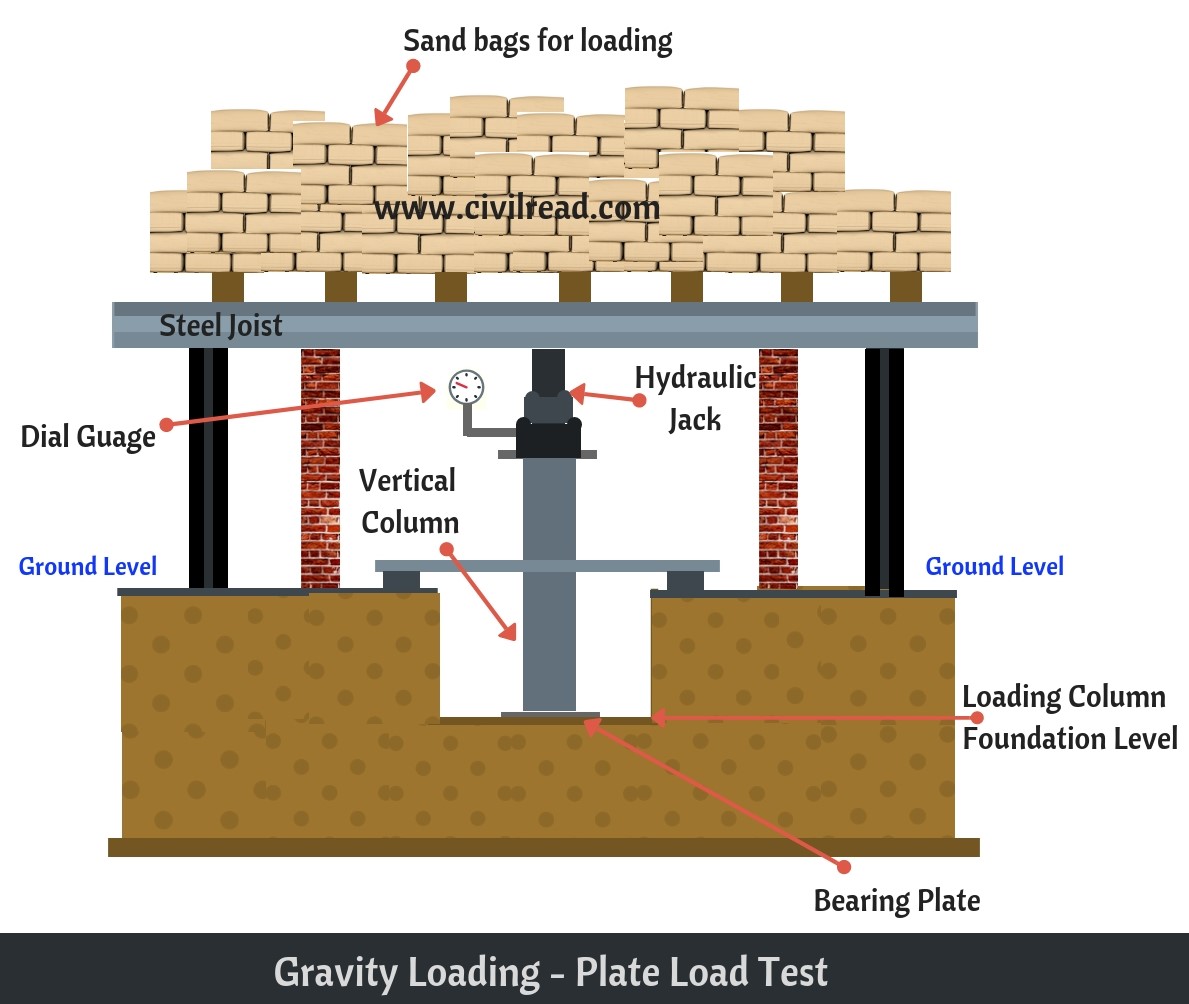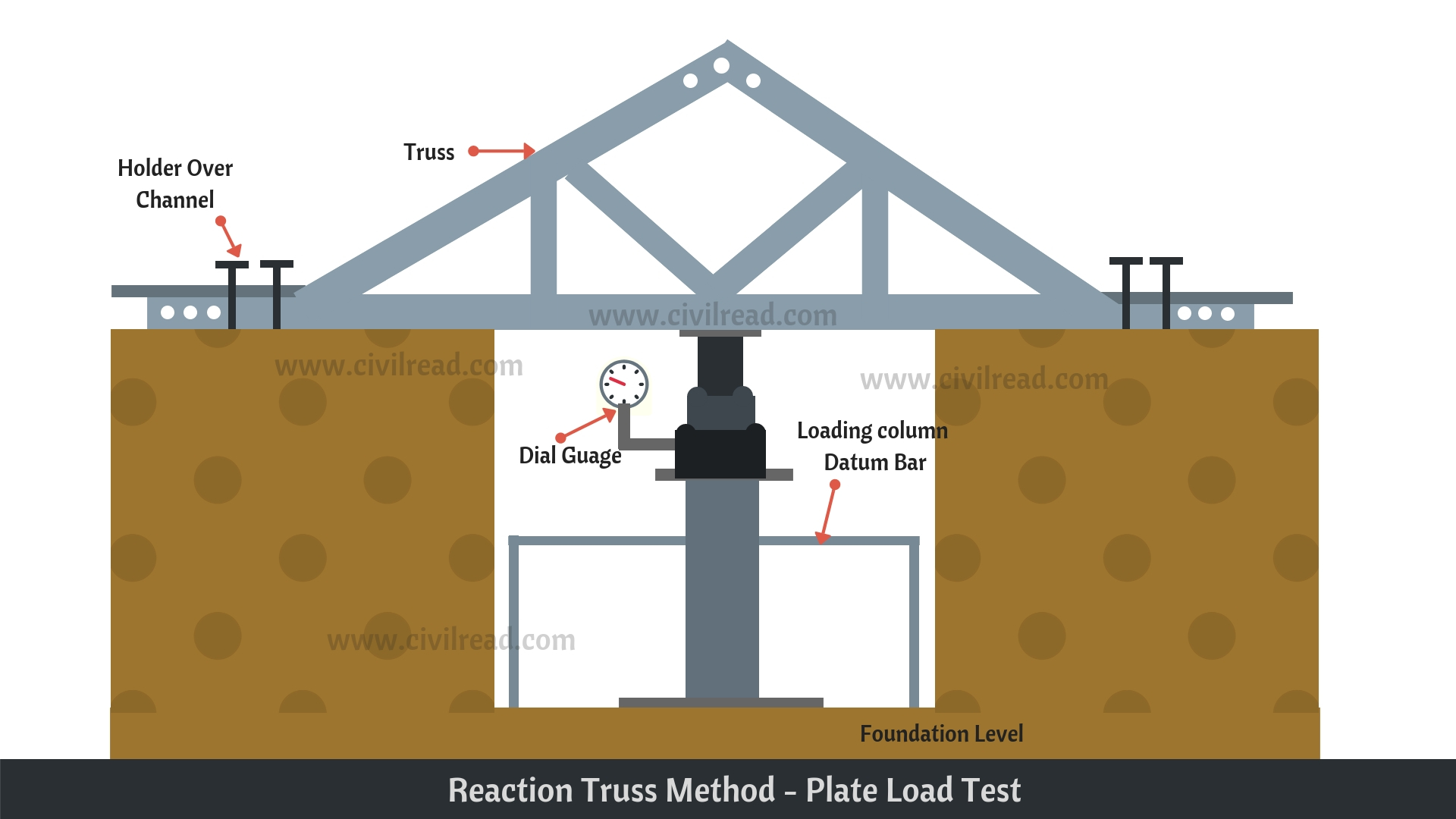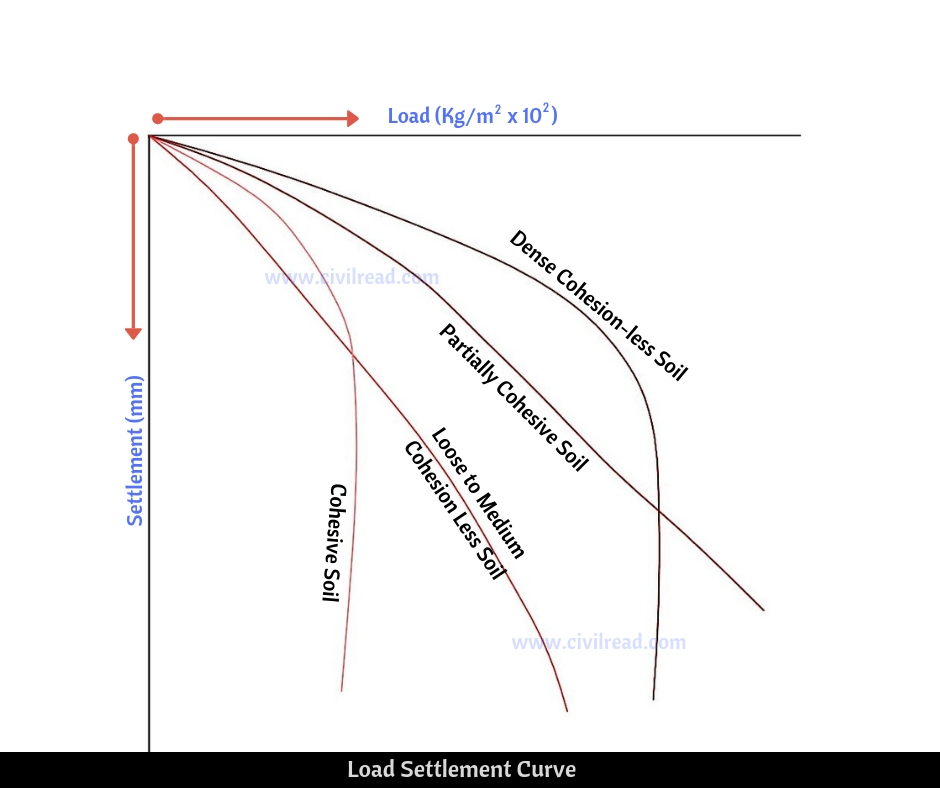Plate load test is performed to determine the ultimate load bearing capacity of soil over the in-situ conditions. The plate load test is mandatory in case of designing foundation over the sandy and clayey soil. This test gives the highest rate of accuracy determining the safe bearing capacity of soil in case of shallow foundations.
This test determines the Ultimate Bearing capacity of Soil, Settlement of foundation & Allowable bearing pressure of soil. Plate load test is suitable for Cohesionless soil as in case of Cohesion soil the settlement takes place in longer duration which this test is not suitable.
In this test, the square rigid plate having dimensions 300mm x 300mm or Circular rigid plate having dia 300mm (larger dia plates may also used if the soil is in very loose condition) is placed on a foundation and load is applied in increments on the plate with the help of hydraulic jack. Then the settlement per each load increment is recorded to calculate the bearing capacity of the soil. This test is also known as Plate bearing test procedure and calculation is clearly explained below.
Contents
- Importance of Plate load test or Plate bearing test?
- Factors affecting Safe Bearing Capacity of Soil (SBC):-
- Varieties in Plate load test and their durations:-
- Plate Load Test:-
- 1.Gravity load test
- (adsbygoogle = window.adsbygoogle || []).push({});
- 2.Reaction truss method
- Apparatus to Plate load test
- Procedure for Plate load test:
- Results recording:
- Precautions:
- Plate Load test calculation:
- Formula for Plate Load Test:-
- Result of Plate Load Test:
Importance of Plate load test or Plate bearing test?
The importance of plate load test lies upon the factors as it helps in determining the best type of foundation. As in case if the safe bearing capacity (SBC) of the soil is less, then we need to adopt raft foundation and in case if the soil conditions are detrimental then we need to perform analysis of the soil as per recommendations.
Factors affecting Safe Bearing Capacity of Soil (SBC):-
Upon various factors which might affect the safe bearing capacity of the soil, the one crucially important are:
- Type of soil
- Sub-surface water table
- The density of the soil
- Void ratio
- Porosity
Varieties in Plate load test and their durations:-
Plate load test is performed under two variations:
1) Gravity load test (Reaction Loading method)
2) Reaction truss method
The total duration required to perform a complete test varies from 6-7 days which includes installations, test, dismantling. The results of the test in case of soft strata can be obtained within a few hours whereas in case of hard strata it might take close to a couple of days.
You Can also Refer :
Different types of foundations in civil engineering
Plate Load Test:-
1.Gravity load test
In this type of method, a rigid platform is utilized to transfer loads through loading of sandbags or concrete blocks. These blocks and sandbags act as a dead weight, and whole arrangement rests upon vertical columns. The hydraulic jack is provided in between the rigid plate and top of the column to transfer the load properly.

2.Reaction truss method
In this method, the reaction generated through jack is borne by reaction truss installed over it. The undesirable movement of truss is controlled by soil anchors or nails fixed into the soil with the help of hammers. The most commonly observed truss is made of mild steel sections. In order to curb later movement, truss is locked with guy ropes.

The apparatus used in above mentioned two tests are different, but the principle and calculations involved in finding the safe bearing capacity of the soil are same. The plate bearing test procedure and calculation clearly explained below.
Apparatus to Plate load test
- Excavating tools
- Hydraulic jack (ball socket type with 50 T capacity)
- Mild steel plate (25 mm thickness & (30*30) cm)
- Dial gauges (minimum 3)
- Reaction beam and reaction truss with soil nails
- Plum Bob ( To determine center)
Procedure for Plate load test:
- The pit is excavated over the site of test with the size of 1.5×1.5m and to the depth of proposed foundations.
- One needs to find the centre of excavated pit and portion to the size of the plate is eroded to the depth 1-2 cm.
- Ensure that the foundation area must be 5 times the area of plate and the seating load of 0.07Kg/cm² is applied to prevent undulations below the plate.
- The eroded portion is filled with rock dust in order to counter undulations and that of plate installed is completely horizontal which on later is checked by tube level.
- Spacers are installed over the hydraulic plate on which hydraulic jack is installed.
- The hydraulic jack in order to counter the load applies pressure which in result leads to transmission of pressure over the plate.
- Setting load of 7kN/m² is applied for some time and released. This is followed by the application of safe load with an increment of 30%.
- In case of loading through truss, both free sides are anchored with soil nails with uniformly loading at the ends.
Results recording:
- Dial gauges arranged at the bottom of the pit record are used to record settlement at every 5 minutes for first 30 minutes and every 10 minutes for rest 30 minutes.
- The observation are made until 25 mm settlement is observed which can take few hours for clayey and soft soil or even up-to couple of days for hard strata.
Precautions:
It is utmost necessary that the alignment of spacers, hydraulic jack, (truss/gravity platform) are axially along the straight line so that the load is transferred vertically. The minimum duration of test should be 60min.
Plate Load test calculation:
- The results obtained through test are plotted over the logarithmic graph with loads over the x-axis and settlement over y-axis.
- Ultimate load for the plate can be determined through plots on the graph, which is quite similar to the settlement of plate by 1/5th of width.
- The point at which the graph curve obtained through plots breaks can be used to determine the ultimate load of the plate, which on later can be utilized to determine ultimate bearing and safe bearing capacity of the soil.
- The safe bearing capacity of soil is calculated by dividing ultimate bearing capacity with factor of safety 2 or 3.
- The image below shows four typical curves applied to different soils.

Formula for Plate Load Test:-
Sf = Sp[Bf (Bp + 0.3)/Bp(Bf + 0.3)]²
Settlement of footing in m = Sf
Settlement of plate in m = Sp
width of test plate in m = Bp
width of the footing in m = B
Result of Plate Load Test:
The settlement in the foundation can be determined by following plate load test which on a later basis is handled to the structural designer to design foundation and complete building structure.
Also Read:
Different types of loads on a structure
Safe Bearing capacity of Soil & SBC values of Different types of soils
For Instant updates Join our Whatsapp Broadcast. Save our Whatsapp contact
+91-9700078271 as Civilread and Send us a message “JOIN”Never Miss an update Click on “Allow US” and make us allow or Click on Red notification bell at bottom right and allow notifications.
Stay tuned!
Civil Read Wishes you ALL the BEST for your future.

Sir send information about barbinding
Refer this link:
https://civilread.com/tag/bar-bending-schedule
Thank you sir for barbeinding schedule
book reference sir pls??
Plate load test how to find the master reading mpa & ton ex :600 plate other wise 300mm plate how to find the jack piston and about the mpa a7 ton reading
ex, for sheed — time — dur– load
mpa ton
0.000 0.000
0.042 1.888
0.084 2.375 this master reading how find it , how will get
Sir, please send me the send me the details of test procedures of materials starting from the soil to finishing materials of the construction with reference to the IS codes with permissible values and tolerance for the each material tests.
its already available in our site use search option